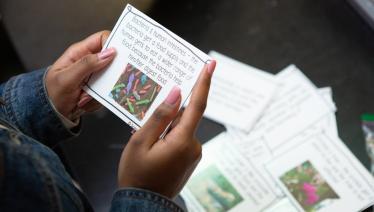Each student comes to school, not only with unique academic needs, but also with unique background experiences, culture, language, personality, interests, and attitudes toward learning. Effective teachers recognize that all of these factors affect how students learn in the classroom, and they adjust, or differentiate, their instruction to meet students' needs.
Getting Started
Tomlinson and Imbeau (2010) describe differentiation as creating a balance between academic content and students' individual needs. They suggest that this balance is achieved by modifying four specific elements related to curriculum:
- Content — the information and skills that students need to learn
- Process — how students make sense of the content being taught
- Product — how students demonstrate what they have learned
- Affect — the feelings and attitudes that affect students' learning
These curriculum-related factors are based on student need in three areas:
- Readiness — students' preparation for learning specific information or skills
- Interest — what appeals to students and thus motivates them to learn
- Learning Profile — how students approach the task of learning
The goal of differentiated instruction is to create learning opportunities that make allowances for differences in how individual students learn in order to ensure equal access to important academic content. Content may be modified for students who need additional practice with essential elements before moving on; however, the expectation is that modifications in other areas will ultimately allow all students to master the same key content.
Thus, "differentiated instruction is not the same as individualized instruction. Every student is not learning something different; they are all learning the same thing, but in different ways. And every student does not need to be taught individually; differentiating instruction is a matter of presenting the same task in different ways and at different levels, so that all students can approach it in their own ways" (Trujo, 2004).
It is important to recognize that differentiated instruction is an approach to teaching, not simply a collection of strategies or activities. Effective differentiation requires ongoing evaluation of students' needs and conscious attention to designing instructional activities and assessment to meet those needs. It is true that teachers must have an extensive repertoire of research-based instructional strategies at hand, but they must also be able to "think outside the box" to ensure that each student's needs are met. As Tomlinson and Imbeau (2010) point out, the teacher's role in the differentiated classroom is to continually ask him/herself, "What does this student need at this moment in order to be able to progress with this key content, and what do I need to do to make that happen?" (p. 14).
Differentiating Instruction for ELLs
With the recent emphasis on standards-based instruction, there has been much discussion about what constitutes appropriate content, instruction, and assessment for English language learners. As educators have grappled with this issue, it has become clear that educational parity can only be achieved if ELLs have an opportunity to learn the same rigorous academic content as native English speakers. The best way to achieve that goal is through differentiated instruction that takes into account ELLs' English language proficiency, as well as the many other factors that can impact learning (Fairbairn & Jones-Vo, 2010).
Differentiated instruction, by definition, is instruction that is designed to support individual students' learning in a classroom of students with varied backgrounds and needs. For this reason, the same general principles that apply to differentiated instruction for native English speakers also apply to ELLs.
Teachers are successful at differentiating instruction for ELLs when they:
- Get to know as much as possible about each student — ELLs represent a wide range of academic skills, interests, languages, English language proficiency levels, and cultures. The more a teacher can learn about each student's background, the better prepared s/he is to provide appropriate instruction for that student.
- Have high expectations for all students — Content should not be "watered down" for students who are still developing English language skills. Creative teachers think of ways to help students understand key material and "show what they know" in ways that match their language proficiency levels.
- Have a variety of research-based instructional strategies at hand — Experienced teachers know that "one-size-fits-all" instruction is rarely successful. There are many different learning profiles in any given classroom, and students learn best when instruction matches their needs and learning styles.
- Use ongoing assessment to guide instruction — Ongoing, informal assessment is vitally important to matching instruction to students' changing needs.
- Provide multiple types of assessment — matching assessment to students' learning profiles and language proficiency ensures that every student has an opportunity to demonstrate what he/she knows.
- Differentiate homework — If all students have the same homework assignments, some are doing busy work while others are struggling with work that they cannot possibly complete successfully (Tomlinson, 2005).
- Collaborate — Instruction is most successful when all of the professionals who work with ELLs work together
- Use flexible grouping — Small group instruction is a very effective way of making sure that all students can access important content, and keeping groups flexible allows teachers to match students with different peers for different types of activities.
- Make content comprehensible for all students (Echevarria, Vogt, & Short, 2008) — Providing ELLs with alternative ways of accessing key content (e.g., charts, books written in their first language, simplified text written by the teacher, discussion, etc.) allows them to learn the same material as other students as they continue to develop their English language skills.
For information on differentiating instruction in the reading classroom, see Differentiated Reading Instruction, a Reading Rockets webcast featuring Carol Ann Tomlinson, Michael Pressley, and Louise Spear-Swerling.
ELLs call attention to the incredible diversity that is characteristic of American schools in the 21st century. Today, most U.S. classrooms include students with a wide variety of academic needs, cultural backgrounds, learning styles, and languages. Differentiated instruction offers teachers an effective method of addressing the needs of this diverse population in a way that gives all students equal access to learning.
Videos from Larry Ferlazzo and Katie Hull Sypnieski
Differentiation for ELLs 101
These videos are part of a series created for Education Week by Larry Ferlazzo and Katie Hull Sypnieski.
Differentiating Instruction: It's Not as Hard as You Think
Differentiating Instruction: A Guide for Teaching English-Language Learners
Differentiating Instruction: How to Plan Your Lessons

